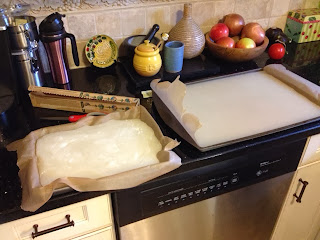Before the temperature got too cold in November, I made some "bee candy" for the first time. I was surprised at how well it went! I certainly would not go back to purchasing fondant - of course, I say that without yet knowing whether the candy will contribute to their winter survival. Here's the recipe:
- 1 cup water and 10 lbs. granulated sugar (or a 1 to 4 ratio).
- Add 1/4 tsp. per vinegar per pound of sugar.
- Bring to boil, stirring constantly until boiling commences.
- Boil without stirring for 3 minutes, covered.
- Insert thermometer, and boil uncovered until 234F is reached.
- Remove from heat, and allow to cool to 200F.
- Whip with whisk until whiteness occurs.
- Pour (QUICKLY!) onto waxed paper having a towel beneath.
- Allow to cool undisturbed.
- Remove waxed paper, and store each cake in a plastic bags.
Here's a picture of the final product:
I was surprised at how well it worked. I used 10 pounds of sugar, and 1 cup of water. I think using more water would have resulted in a more pliable candy. My candy is pretty hard. However, I did not want any excess moisture in the candy, because last year my pliable fondant froze to resemble hard glass by spring. I assume the bees have an easier time eating something that is not essentially, ice. And a pliable bee candy will be hard as a rock when it freezes anyway.
I added an empty hive body on top of the hive; stapled hardware cloth at the bottom (with holes big enough for bees); wrapped the bee candy in news paper; and placed the candy and a pollen patty in the empty hive body on top of the hardware cloth. I covered the top hive body with the inner cover and put the lid on.
I did not add any extra ventilation, though I know it is recommended. I basically don't know what do to in terms of ventilation, so I do nothing. I'm so concerned about the bees being subject to wind drafts and icy rain, etc.
I usually use the pest bottom board to help with ventilation in winter, but at the moment it is not in place, and I assume its absence is helping with ventilation. I really have no idea whether it is better to put the pest board in place or not in winter. If we have a big drop in temperature, I will probably put it in.
Last year I wrapped the hive in tar paper. I'm not convinced it helped all that much, however. I have not taken that step yet this year.
